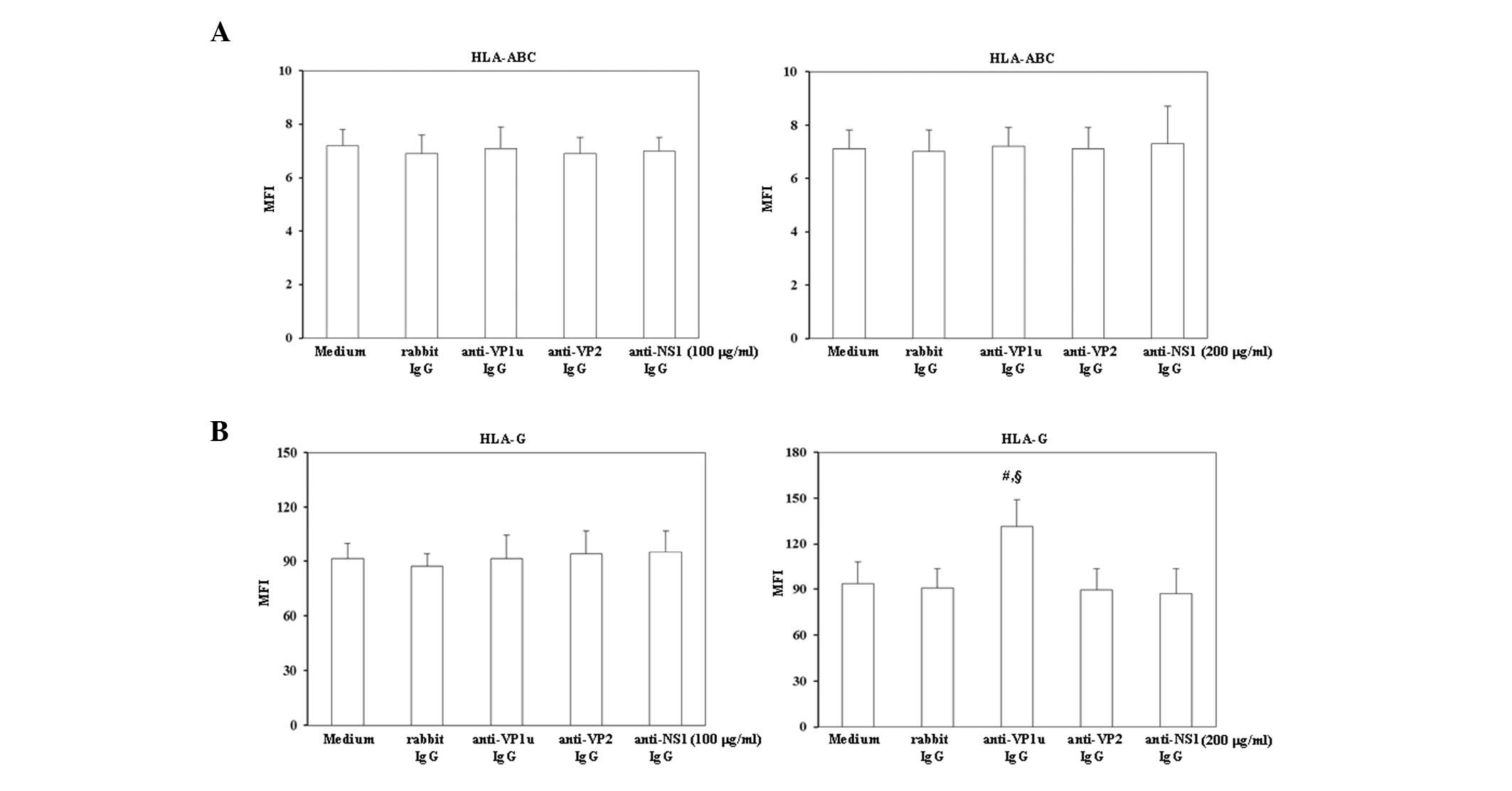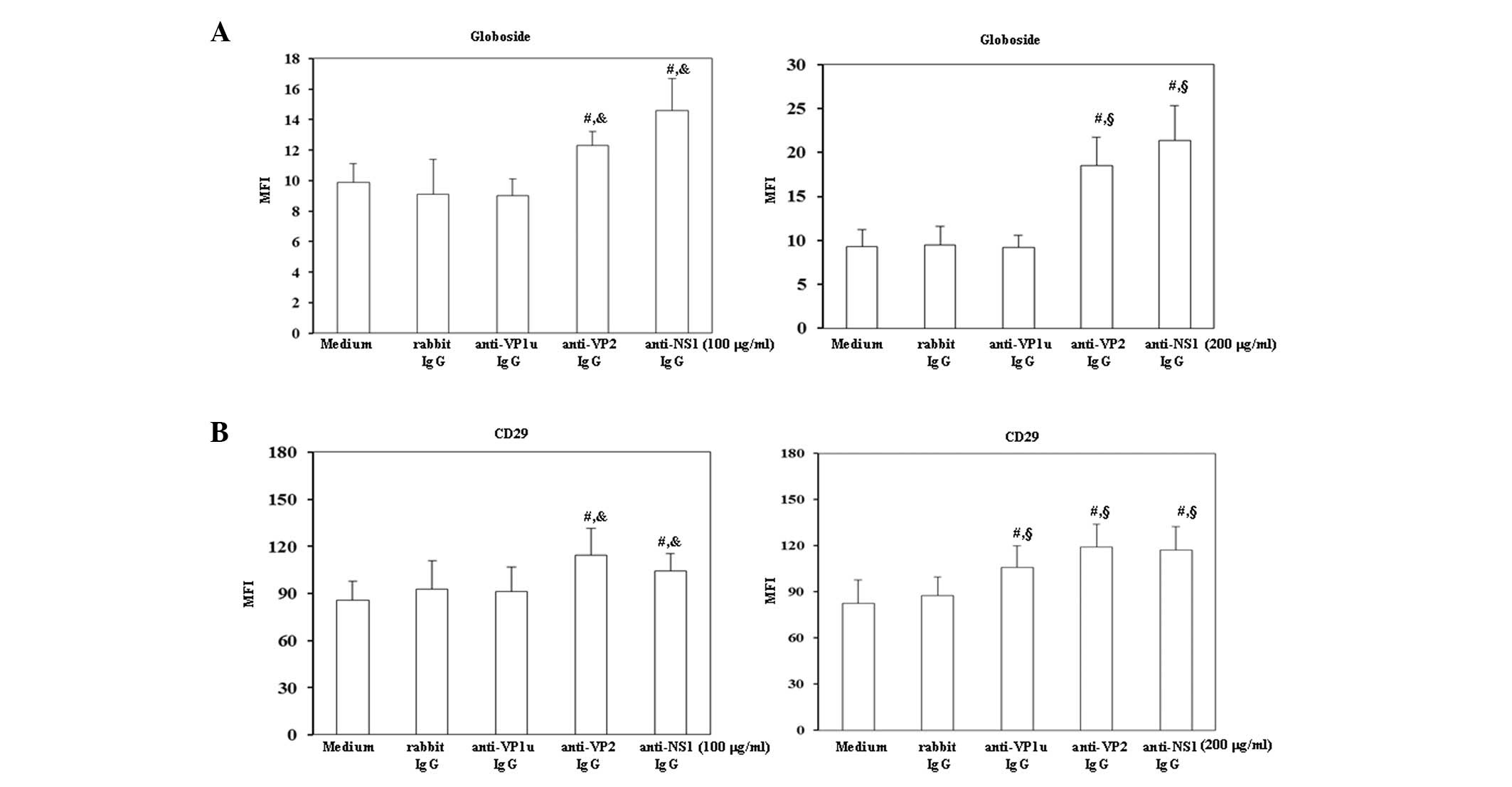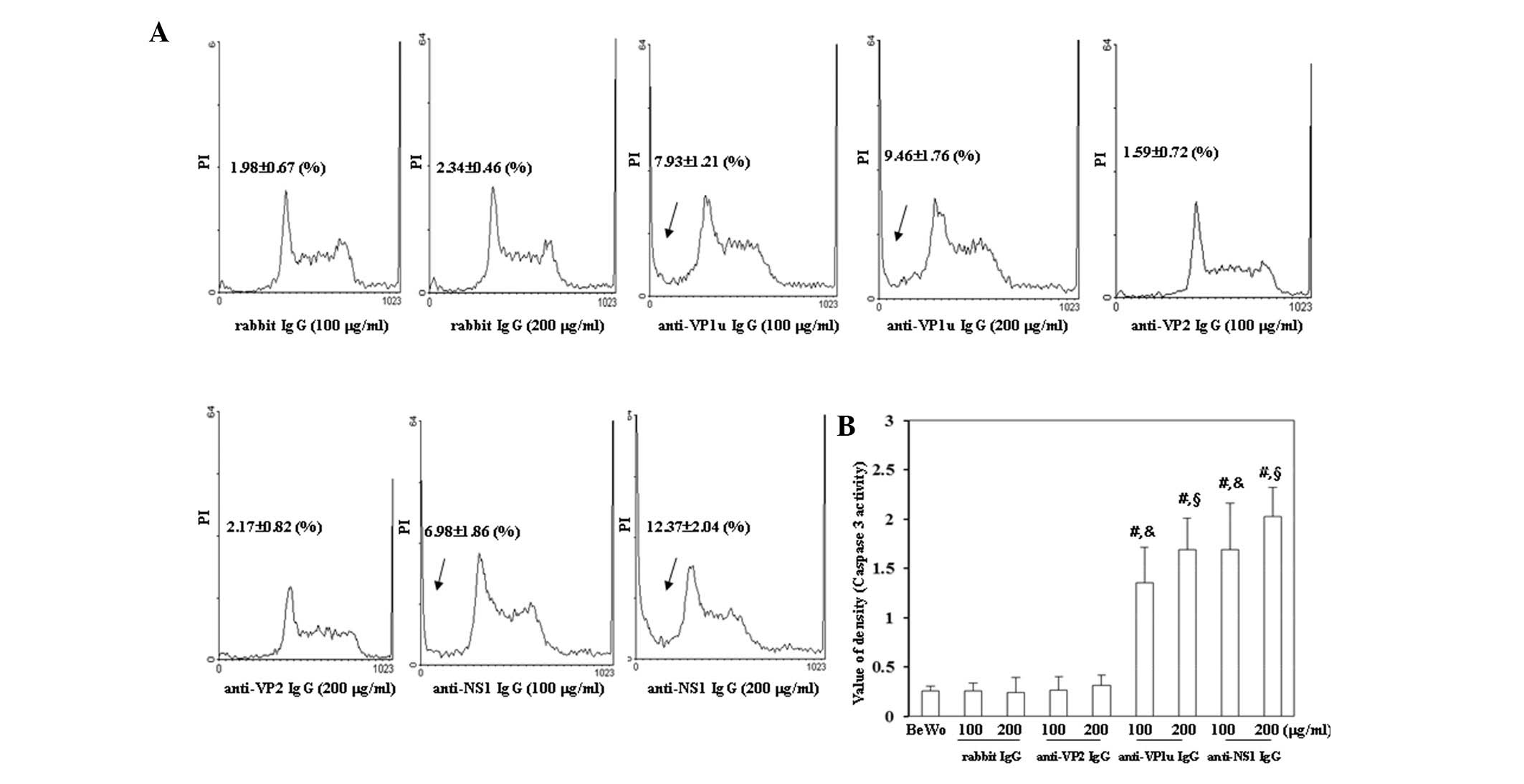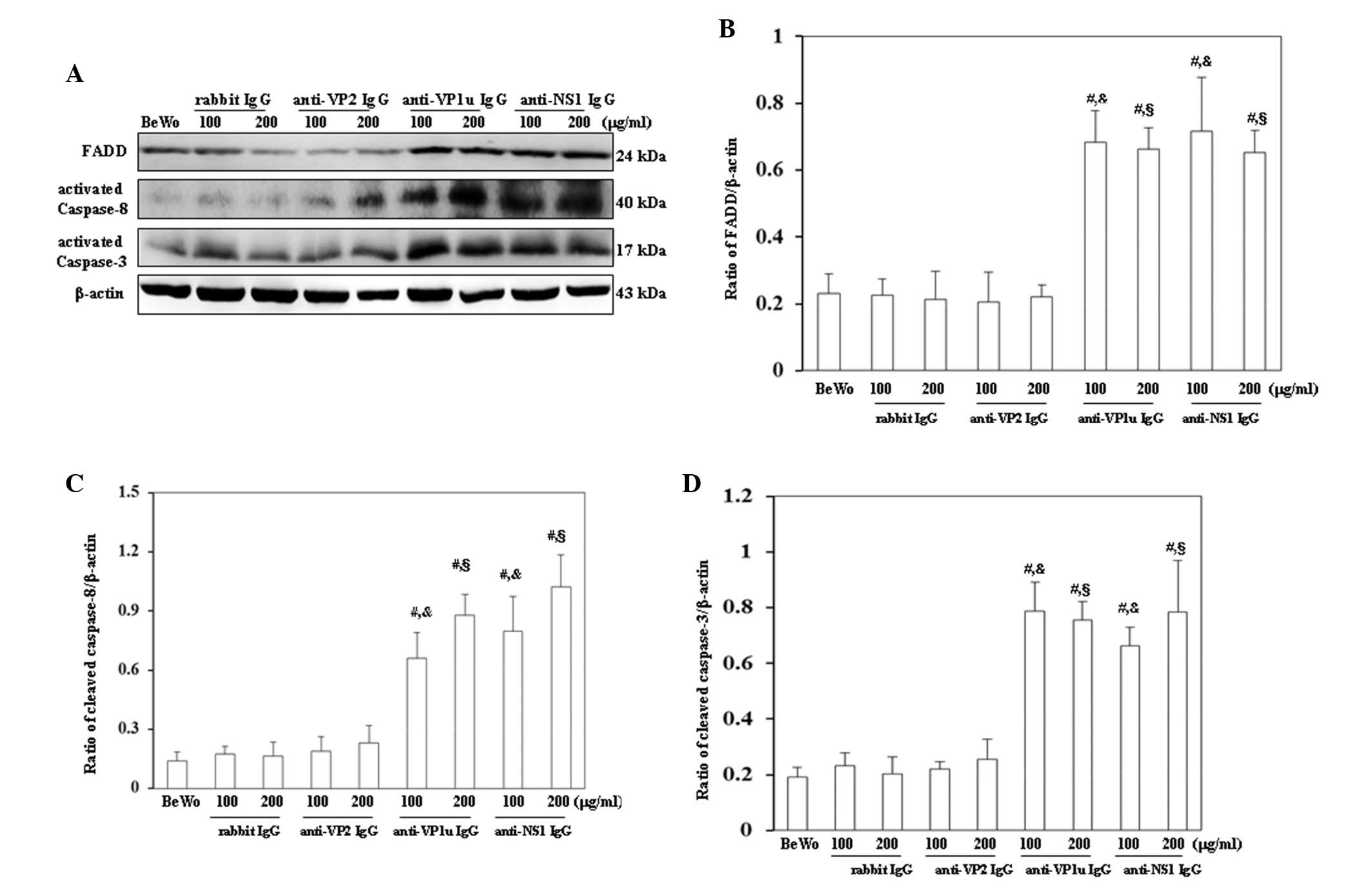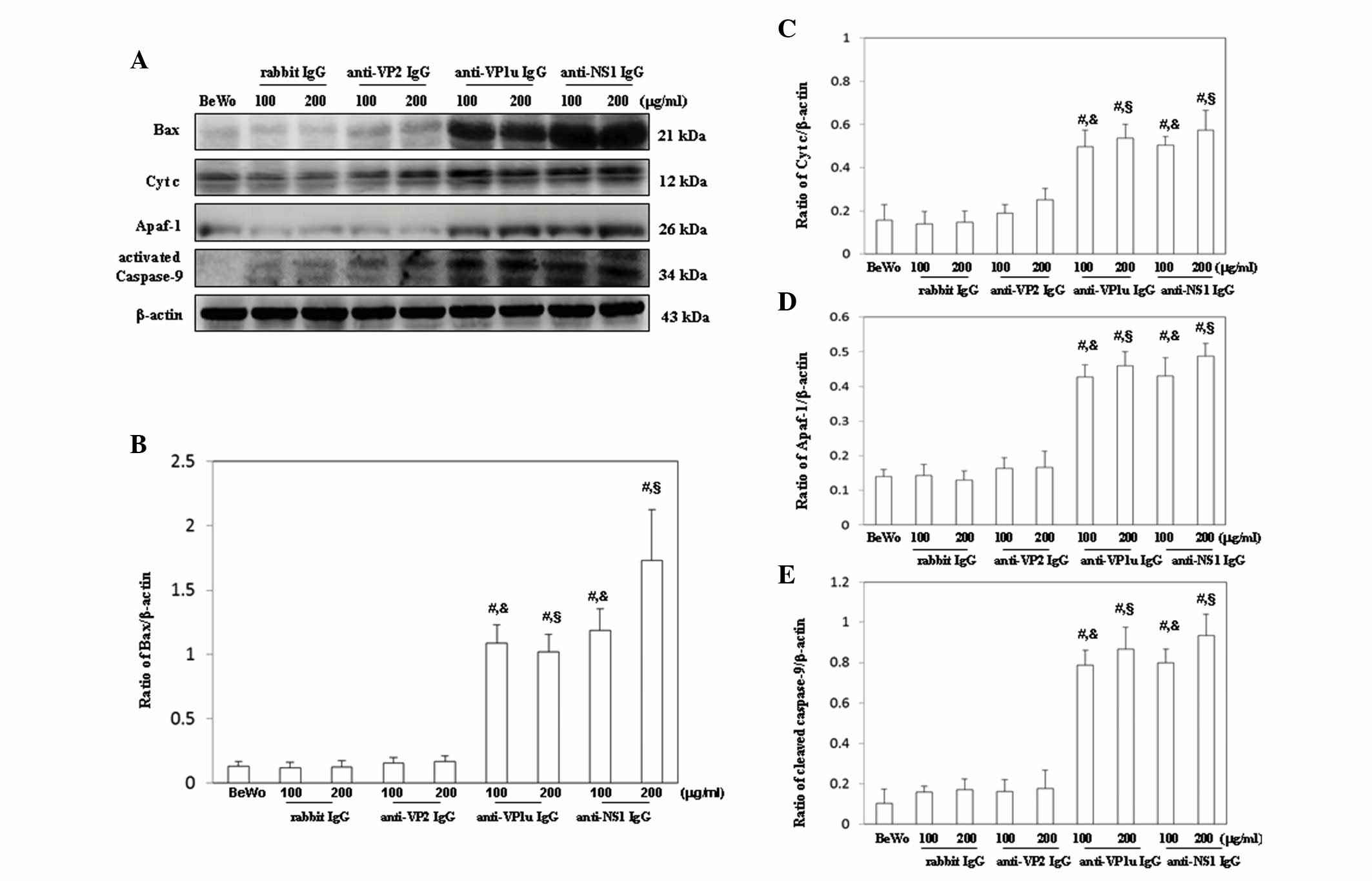Human parvovirus B19 antibodies induce altered membrane protein expression and apoptosis of BeWo trophoblasts
- Authors:
- Published online on: September 26, 2016 https://doi.org/10.3892/mmr.2016.5787
- Pages: 4399-4406
Abstract
Introduction
Human parvovirus B19 (B19) is a small, non-enveloped, single-stranded DNA virus in the Erythrovirus genus of the Parvoviridae family (1). The left side of the B19 genome encodes nonstructural protein 1 (NS1), whereas the right side encodes two capsid proteins: VP1 and VP2, which are identical disregarding the 227 amino acids at the amino-terminal end of the VP1 protein, termed the VP1 unique region (VP1u) (2). The B19 virus, which was initially discovered in 1975 (1), is associated with various clinical manifestations, including rash, thrombocytopenia, leukopenia, fetal wastage, hypocomplementemia, autoimmune hemolytic anemia, arthritis, vasculitis and systemic lupus erythematosus (3–5).
B19 can be transmitted by blood and blood-derived products, and can also be transmitted vertically from mother to fetus (6). The P blood group antigen (P-antigen) was first discovered in 1927, while identifying novel human blood group antigens by immunizing rabbits with human erythrocytes (7). Globoside, an alternative name for the P-antigen, is the major cellular receptor for B19 infection, and is a neutral glycosphingolipid that is predominantly found on erythroid cells and their progenitors (8,9). As well as globoside, α5β1 integrin and Ku80 autoantigen have been identified as co-receptors of B19 infection. The expression levels of α5β1 integrin and P-antigen are believed to be associated with restricted cellular lineage for B19 entry (10). In addition, induction of Ku80 proteins on cell surfaces is involved in the pathologic immunity associated with B19 infection (11).
B19 induces cytotoxic effects in infected cells via the promotion of cell cycle arrest and apoptosis (12). Although women exposed to B19 in pregnancy are usually asymptomatic, ~3% of infected women exhibit severe clinical symptoms, including hydrops fetalis and fetal mortality (13,14). Furthermore, various prospective studies have reported that the risks of developing hydrops fetalis and of fetal mortality during pregnancy are significantly higher in patients with B19 infection, as compared with in controls (15–17). B19 infection, alongside the induction of antibodies against B19 viral proteins, during pregnancy has been associated with various disorders, particularly hydrops fetalis and fetal mortality (18,19); however, the effects of antibodies against B19 viral proteins during pregnancy remain unclear. The present study used human BeWo trophoblasts to investigate the effects of anti-B19 antibodies, and aimed to provide a possible explanation for the transmission of the B19 virus during pregnancy.
Materials and methods
Ethics
Animal experiments were approved by the Institutional Animal Care and Use Committee at Chung Shan Medical University (Taichung, Taiwan; IACUC approval no. 1130). Animal welfare and experimental procedures were performed according to the National Institutes of Health Guide for the Care and Use of Laboratory Animals (8th edition).
Rabbit anti-B19-VP1u/VP2/NS1 immunoglobulin G (IgG) antibodies
Preparations of B19-VP1u, B19-VP2 and B19-NS1 recombinant proteins were performed as described in our previous study (20). Yields of the purified recombinant B19-NS1, B19-VP1u and B19-VP2 proteins were 5.7, 4.1 and 8.7 mg/l, and their purities approximated 97.3, 98.1 and 96.8%, respectively. New Zealand White rabbits (age, 6 months; weight, 2–3 kg; Lu-Ho Rabbit Farm, Chunghua, Taiwan) were maintained under a 12 h light-dark cycle, and ambient temperature was maintained at 24–26°C. The rabbits had ad libitum access to water and standard laboratory chow. Control rabbit IgG antibodies and IgG antibodies against the various B19 viral proteins were prepared by subcutaneously immunizing two female New Zealand White rabbits per group in the neck region with Freund's complete adjuvant (Sigma-Aldrich; Merck Millipore, Darmstadt, Germany; control group), or with 0.5 mg purified recombinant B19-VP1u (VP1u group), B19-VP2 (VP2 group) or B19-NS1 (NS1 group) in Freund's complete adjuvant. After the first immunization, the various groups were immunized at 2-week intervals with Freund's incomplete adjuvant, or with 0.25 mg B19-VP1u, B19-VP2 or B19-NS1 recombinant proteins in Freund's incomplete adjuvant. The experimental period lasted for 8 weeks. The rabbits were anesthetized with chloral hydrate (1 ml/25 g) prior to CO2 asphyxiation. Blood samples were obtained from the rabbits for antibody extraction. The rabbit IgG antibodies were subsequently purified by protein G agarose (Roche Life Science, Indianapolis, IN, USA) chromatography. Each eluent was concentrated using a Centricon-P10 column (Amicon; EMD Millipore, Billerica, MA, USA) and filtered using a 0.22 µm microporous membrane (EMD Millipore) (21). Endotoxin tests were conducted using the Limulus Amebocyte Lysate Endochrome Assay (Charles River Laboratories, Inc., Charleston, SC, USA). The endotoxin levels were found to be below the detection limit [0.25 endotoxin unit (EU) ml-1] for all IgG preparations at the concentrations used in the present study.
Cell culture and treatment
The BeWo choriocarcinoma cell line (no. BCRC-60073), which is the most extensively used cellular model of placental trophoblasts, was purchased from the Bioresource Collection and Research Center (Food Industry Research and Development Institute, Hsinchu, Taiwan). The cells were maintained in 75 cm2 Falcon flasks (BD Biosciences, Erembodegem, Belgium) under standard culture conditions at 37°C in an atmosphere containing 5% CO2. The culture medium comprised 85% F-12 nutrient mixture (Ham) (Gibco; Thermo Fisher Scientific, Inc., Waltham, MA, USA) supplemented with 2 mM L-glutamine, 100 U/ml penicillin, 100 µg/ml streptomycin and 15% heat-inactivated fetal calf serum (Gibco; Thermo Fisher Scientific, Inc.). For treatments, BeWo trophoblast cells were grown to confluence and were incubated with 100 or 200 µg/ml purified rabbit IgG antibodies for 24 h as described previously (21).
Flow cytometric analysis
Cells were seeded in culture plates at 1×106 cells/100 mm2 for flow cytometry. The cell monolayers were cultured in serum-free F12 medium for 24 h at 37°C in a 5% CO2 incubator. Cells were then incubated for 24 h with the following antibodies: i) Affinity-purified IgG (100 or 200 µg/ml) from control rabbits that were immunized with adjuvant; ii) affinity-purified rabbit anti-B19-VP1u, anti-B19-VP2 or anti-B19-NS1 IgG (100 or 200 µg/ml), or iii) medium alone. After incubation, the cells were harvested, washed with PBS, and were fixed with 70% alcohol for 12–16 h at 4°C. The cells were then washed with PBS and transferred to 12×75-mm tubes. Human leukocyte antigen (HLA)-ABC (cat. no. 555553), β1 integrin [cluster of differentiation (CD)29 (cat. no. 556049); BD Biosciences, San Diego, CA, USA] or human HLA-G (cat. no. 335906) (BioLegend, Inc., San Diego, CA, USA) were detected by adding 20 µl phycoerythrin-conjugated mouse anti-human monoclonal antibodies. Globoside was detected by incubating the cells with rabbit polyclonal anti-globoside GL4 (cat. no. ab23949; Abcam, Cambridge, UK), followed by rhodamine-conjugated secondary antibody (cat. no. AP132R; Chemicon; EMD Millipore). The stained cells were analyzed using a FASCSCalibur analyzer (BD Biosciences, Bedford, MA, USA). In addition, the cells (~2×106) were fixed in 75% alcohol for 12–16 h at 4°C. Subsequently, the cells were treated with RNase (1 mg/ml) at 25°C for 30 min, and were stained with propidium iodide (10 mg/ml) for 30 min prior to cell cycle analysis with a flow cytometer. For each sample, 10,000-gated events were collected, and mean fluorescence intensity was analyzed. For each molecule, all staining procedures were performed in a single batch to avoid inter-batch variation.
ELISA
Analysis of caspase-3 activity was performed in triplicate using the caspase-3, Active Form, ELISA pair kit (BD Biosciences, San Diego, CA, USA) according to the manufacturer's protocol.
Immunoblotting
Immunoblotting was performed as described previously (22). Briefly, protein samples were denatured for 5 min in boiling water containing sample buffer (0.0625 M Tris-HCl buffer, pH 6.8; 2.3% SDS, 5% 2-mercaptoethanol, 10% glycerol). Samples were separated on a 12.5% acrylamide gel (100–150 V; 1.5 h) and were electrophoretically transferred to nitrocellulose membranes (Amersham; GE Healthcare, Piscataway, NJ, UK). The membranes were then incubated in PBS containing 5% nonfat dry milk for 30 min at room temperature, in order to saturate irrelevant protein binding sites. Antibodies against Fas-associated death domain protein (FADD; cat. no. sc-6035), activated caspase-8 (cat. no. sc-166320), activated caspase-3 (cat. no. sc-7148), B-cell lymphoma 2-associated X protein (Bax; cat. no. sc-7480), cytochrome c (cat. no. sc-13156), apoptotic peptidase activating factor 1 (Apaf-1; cat. no. sc-8339), activated caspase-9 (cat. no. sc-7885) (1:500; Santa Cruz Biotechnology, Inc., Dallas, TX, USA) and β-actin (1:5,000; MAB1501, Chemicon; EMD Millipore, Temecula, CA, USA) were diluted in PBS with 2.5% bovine serum albumin. Membranes were incubated with the antibodies for 1.5 h with gentle agitation at room temperature. After washing twice with PBS-0.05% Tween, horseradish peroxidase (HRP)-conjugated secondary antibody (cat. nos. sc-2004 or sc-2005; Santa Cruz Biotechnology, Inc.) was added to the blots, which were incubated for a further 1 h. Immobilion Western HRP Chemiluminescent Substrate (EMD Millipore) was then used to detect the antigen-antibody complexes. The blots were scanned and semi-quantified by densitometry (Alpha-Imager 2200; ProteinSimple, San Jose, CA, USA).
Statistical analysis
Statistical analyses were performed using GraphPad Prism 5 software (GraphPad Software, Inc., La Jolla, CA, USA) by one-way analysis of variance followed by Tukey multiple-comparisons test. Data are presented as the mean ± standard error of the mean, and results were verified in at least three independent experiments. P<0.05 was considered to indicate a statistically significant difference.
Results
Effects of rabbit anti-B19 IgG on the expression levels of HLA-ABC and HLA-G
To investigate whether trophoblasts were activated by antibodies against B19 viral proteins, the expression levels of HLA-ABC and HLA-G were analyzed by flow cytometry (Fig. 1). As shown in Fig. 1A, treatment with 100 or 200 µg/ml control rabbit IgG, rabbit anti-B19-VP1u, anti-B19-VP2 and anti-B19-NS1 IgG did not significantly increase HLA-ABC expression on BeWo trophoblasts. Notably, HLA-G expression was significantly increased on BeWo trophoblasts treated with 200 µg/ml rabbit anti-B19-VP1u IgG (Fig. 1B). Conversely, no significant variation in HLA-G expression was detected on BeWo trophoblasts treated with 200 µg/ml rabbit anti-B19-VP2 and anti-B19-NS1 IgG compared with those treated with control rabbit IgG.
Effects of rabbit anti-B19 IgG on the expression levels of globoside and CD29
To investigate the effects of antibodies against B19 viral proteins on B19 receptors, the expression levels of globoside, i.e., P-antigen, and CD29, also known as β1 integrin, were detected on BeWo trophoblasts. As shown in Fig. 2A globoside expression was significantly increased on BeWo trophoblasts treated with 100 or 200 µg/ml rabbit anti-B19-VP2 and anti-B19-NS1 IgG compared with those treated with control rabbit IgG. Furthermore, the expression levels of CD29 were significantly increased on BeWo trophoblast cells treated with 200 µg/ml rabbit anti-B19-VP1u IgG, and with 100 or 200 µg/ml rabbit anti-B19-VP2 and anti-B19-NS1 IgG compared with those treated with control rabbit IgG.
Effects of rabbit anti-B19 IgG on the induction of apoptosis
To investigate whether antibodies against B19 viral proteins were able to induce apoptosis of BeWo trophoblasts, flow cytometry and a caspase-3 activity assay were performed. As shown in Fig. 3A, the number of cells in sub-G1 phase was significantly increased in BeWo trophoblasts treated with 100 or 200 µg/ml anti-B19-VP1u and anti-B19-NS1 IgG compared with those treated with control rabbit IgG. Conversely, the sub-G1 population was not significantly different between BeWo trophoblasts treated with control rabbit IgG and anti-B19-VP2 IgG. In addition, caspase-3 activity was significantly increased in BeWo trophoblasts treated with 100 or 200 µg/ml anti-B19-VP1u and anti-B19-NS1 IgG compared with those treated with control rabbit IgG (Fig. 3B).
Effects of rabbit anti-B19 IgG on the expression levels of apoptotic molecules
For further confirmation that apoptosis was induced by anti-B19 antibodies, the expression levels of molecules associated with the extrinsic and intrinsic apoptotic pathways were examined. As shown in Fig. 4A, FADD, activated caspase-8 and activated caspase-3 were significantly increased in BeWo trophoblasts treated with 100 or 200 µg/ml anti-B19-VP1u and anti-B19-NS1 IgG compared with those treated with control rabbit IgG. Conversely, FADD, activated caspase-8 and activated caspase-3 expression levels were not significantly different between BeWo trophoblasts treated with control rabbit IgG and anti-B19-VP2 IgG (Fig. 4A). The results of western blotting were semi-quantified, as presented in Fig. 4B-D. Furthermore, Bax, cytochrome c, Apaf-1 and activated caspase-9 were significantly increased in BeWo trophoblasts treated with 100 or 200 µg/ml anti-B19-VP1u and anti-B19-NS1 IgG compared with those treated with control rabbit IgG (Fig. 5A). Conversely, no significant difference in Bax, cytochrome c, Apaf-1 and activated caspase-9 expression was detected between BeWo trophoblasts treated with control rabbit IgG and anti-B19-VP2 IgG (Fig. 5A). The results of western blotting were semi-quantified, as presented in Fig. 5B-E.
Discussion
Fetal trophoblasts, maternal leukocytes, stromal cells and endothelial cells in the maternal-fetal interface comprise the decidua, and orchestrate placental vascularization and tissue remodeling (23,24). Notably, fetal trophoblasts serve crucial roles in modulating maternal immune responses, and educate leukocytes, endometrial stromal cells and endothelial cells to prepare a receptive decidual microenvironment that is required for a successful pregnancy (25,26). When the placental interface is forming with the maternal systemic circulation, fetal trophoblasts begin to express HLA-G (23). HLA-G, which is a non-classical HLA class I molecule, was initially discovered on fetal trophoblasts in 1986 (27). HLA-G is predominantly expressed on fetal trophoblasts and is endowed with immune-regulatory functions, which are known to suppress immune responses and induce tolerance during pregnancy (24). Increased HLA-G expression has also been associated with several immunological diseases, including multiple sclerosis, asthma, allergic rhinitis and hepatitis C virus-induced liver fibrosis (28,29). These previous studies suggested that HLA-G has roles in normal physiological and pathological processes. Notably, the present study demonstrated that anti-B19-VP1u IgG significantly increased HLA-G expression on BeWo trophoblasts. Although HLA-ABC expression is associated with B19 transmission and replication in fetal erythroid progenitor cells (30), HLA-ABC expression was not significantly altered among BeWo trophoblasts treated with anti-B19-VP1u, anti-B19-VP2 and anti-B19-NS1 IgG. These findings indicated that anti-B19-VP1u, anti-B19-VP2 and anti-B19-NS1 IgG have different effects on HLA-G expression, but not on HLA-ABC expression, on BeWo trophoblasts. Therefore, it may be hypothesized that anti-B19-VP1u, anti-B19-VP2 and anti-B19-NS1 IgG have pathological roles in disrupting the maternal-fetal interface via altering the expression of HLA-G. However, further studies are required to verify the precise mechanism.
In addition to erythroid lineage cells, globoside is known to be expressed on human placental trophoblasts (31). Globoside, namely P-antigen, and its co-receptor, α5β1 integrin, are known to be major receptors for B19 infection. The P-antigen is required for primary B19 attachment to permissive cells via the VP2 capsid protein, and subsequent high-affinity conformation by α5β1 integrin is needed to trigger the internalization step and enhance the probability of productive infections (8,10,32). Absence of P-antigen or α5β1 integrin is associated with loss of cellular attachment, which may occur independently of viral infection (33). These previous findings suggested that increased expression of P-antigen or its co-receptors may facilitate pathological processes after B19 infection. Notably, the present study demonstrated that antibodies against B19-VP2 and B19-NS1 were able to induce the expression of globoside and CD29, whereas anti-B19-VP1u only induced the expression of CD29. These findings indicated that various antibodies may have different pathological roles against B19 viral proteins, and may facilitate the transmission of B19 across the maternal-fetal interface via the activation of B19 receptors.
The placenta is a barrier that separates the fetal and maternal blood and lymphatic systems. Within the placenta, fetal trophoblasts serve crucial roles in evading recognition by the maternal immune system and in defending against microorganisms (34). Trophoblasts in the placenta differentiate into villous and extravillous trophoblasts, which provide epithelial cover of the placental villous tree in direct contact with maternal blood, and invade maternal uterine tissues resulting in direct contact with the maternal stromal and immune cells, respectively (35). Apoptosis of either type of trophoblast may cause severe conditions, including pre-eclampsia and intrauterine growth restriction. Abnormal apoptotic regulation of villous and/or extravillous trophoblasts may also result in altered trophoblast invasion and/or shedding into the maternal circulation. Notably, an association between B19-induced fetal mortality and increased apoptosis of placental villous trophoblasts has been reported (36). Damage due to apoptotic death of the placental trophoblast layer can compromise the integrity of the protective barrier and have a role in pathogenesis (36). Previous studies have reported that B19 viral proteins induce apoptosis in vitro and in vivo (37,38); however, little is currently known regarding the effects of antibodies against B19 viral proteins on placental trophoblasts during pregnancy. Notably, the present study detected a significantly increased sub-G1 population; caspase-3 activity; and expression of proteins associated with intrinsic and extrinsic apoptotic signaling in BeWo trophoblasts following treatment with anti-B19-VP1u and anti-B19-NS1 IgG. Therefore, significantly increased apoptosis of BeWo trophoblasts caused by anti-B19-VP1u and anti-B19-NS1 IgG may provide a rational explanation for the transmission of B19 into the fetus.
Induction of anti-B19 antibodies due to B19 infection is associated with numerous severe disorders during pregnancy; however, information regarding the effects of these antibodies on trophoblasts is limited. The present study is the first, to the best of our knowledge, to reveal the effects of anti-B19-VP1u, anti-B19-NS1 and anti-B19-VP2 IgG on HLA-G, globoside and CD29 expression, and the induction of intrinsic and extrinsic apoptotic cascades in BeWo trophoblasts. The results of the present study provide a possible explanation for the role of anti-B19 antibodies in disrupting the fetal-maternal barrier via modulating HLA-G, globoside and CD29 expression, and inducing apoptosis of trophoblast cells.
Acknowledgements
The present study was supported in part by grants from the National Science Council (nos. NSC 98-2314-B-040-008-MY3 and NSC 101-2314-B-040-008), the Department of Health (no. North 98030), and the Chung Shan Medical University Hospital, Taiwan R.O.C. (no. CSH-2014-C-013). The funders had no role in study design, data collection and analysis, decision to publish, or preparation of the manuscript. The authors would also like to thank Mr. Ted Knoy (Writing Center, Hsinchu, Taiwan, R.O.C.) for his editorial assistance. Analyses using the FASCSCalibur, luminescent image analyzer and digital imaging analyzer were performed at the Instrument Center of Chung Shan Medical University, which is supported by the National Science Council, Ministry of Education and Chung Shan Medical University.
References
|
Cossart YE, Field AM, Cant B and Widdows D: Parvovirus-like particles in human sera. Lancet. 1:72–73. 1975. View Article : Google Scholar : PubMed/NCBI | |
|
Anderson S, Momoeda M, Kawase M, Kajigaya S and Young NS: Peptides derived from the unique region of B19 parvovirus minor capsid protein elicit neutralizing antibodies in rabbits. Virology. 206:626–632. 1995. View Article : Google Scholar : PubMed/NCBI | |
|
Finkel TH, Török TJ, Ferguson PJ, Durigon EL, Zaki SR, Leung DY, Harbeck RJ, Gelfand EW, Saulsbury FT, Hollister JR, et al: Chronic parvovirus B19 infection and systemic necrotizing vasculitis: Opportunistic infection or etiological agent? Lancet. 343:1255–1258. 1994. View Article : Google Scholar : PubMed/NCBI | |
|
Nesher G, Osborn TG and Moore TL: Parvovirus infection mimicking systemic lupus erythematosus. Semin Arthritis Rheum. 24:297–303. 1995. View Article : Google Scholar : PubMed/NCBI | |
|
Rogo LD, Mokhtari-Azad T, Kabir MH and Rezaei F: Human parvovirus B19: A review. Acta Virol. 58:199–213. 2014. View Article : Google Scholar : PubMed/NCBI | |
|
Enders M, Weidner A, Zoellner I, Searle K and Enders G: Fetal morbidity and mortality after acute human parvovirus B19 infection in pregnancy: Prospective evaluation of 1018 cases. Prenat Diagn. 24:513–518. 2004. View Article : Google Scholar : PubMed/NCBI | |
|
Landsteiner K and Levine P: On a specific substance of the cholera vibrio. J Exp Med. 46:213–221. 1927. View Article : Google Scholar : PubMed/NCBI | |
|
Brown KE, Anderson SM and Young NS: Erythrocyte P Antigen: Cellular receptor for B19 parvovirus. Science. 262:114–117. 1993. View Article : Google Scholar : PubMed/NCBI | |
|
Brown KE and Young NS: Parvovirus B19 infection and hematopoiesis. Blood Rev. 9:176–182. 1995. View Article : Google Scholar : PubMed/NCBI | |
|
Weigel-Kelley KA, Yoder MC and Srivastava A: α5β1 integrin as a cellular coreceptor for human parvovirus B19: Requirement of functional activation of b1 integrin for viral entry. Blood. 102:3927–3933. 2003. View Article : Google Scholar : PubMed/NCBI | |
|
Munakata Y, Saito-Ito T, Kumura-Ishii K, Huang J, Kodera T, Ishii T, Hirabayashi Y, Koyanagi Y and Sasaki T: Ku80 autoantigen as a cellular coreceptor for human parvovirus B19 infection. Blood. 106:3449–3456. 2005. View Article : Google Scholar : PubMed/NCBI | |
|
Chisaka H, Morita E, Yaegashi N and Sugamura K: Parvovirus B19 and the pathogenesis of anaemia. Rev Med Virol. 13:347–359. 2003. View Article : Google Scholar : PubMed/NCBI | |
|
Brown T, Anand A, Ritchie LD, Clewley JP and Reid TM: Intrauterine parvovirus infection associated with hydrops fetalis. Lancet. 2:1033–1034. 1984. View Article : Google Scholar : PubMed/NCBI | |
|
Staroselsky A, Klieger-Grossmann C, Garcia-Bournissen F and Koren G: Exposure to fifth disease in pregnancy. Can Fam Physician. 55:1195–1198. 2009.PubMed/NCBI | |
|
Rodis JF, Quinn DL, Gary GW Jr, Anderson LJ, Rosengren S, Cartter ML, Campbell WA and Vintzileos AM: Management and outcomes of pregnancies complicated by human B19 parvovirus infection: A prospective study. Am J Obstet Gynecol. 163:1168–1171. 1990. View Article : Google Scholar : PubMed/NCBI | |
|
Gratacós E, Torres PJ, Vidal J, Antolín E, Costa J, Jiménez de Anta MT, Cararach V, Alonso PL and Fortuny A: The incidence of human parvovirus B19 infection during pregnancy and its impact on perinatal outcome. J Infect Dis. 171:1360–1363. 1995. View Article : Google Scholar : PubMed/NCBI | |
|
Koch WC, Harger JH, Barnstein B and Adler SP: Serologic and virologic evidence for frequent intrauterine transmission of human parvovirus B19 with a primary maternal infection during pregnancy. Pediatr Infect Dis J. 17:489–494. 1998. View Article : Google Scholar : PubMed/NCBI | |
|
Schwarz TF, Roggendorf M and Simader R: Association of non-immunologically-induced hydrops fetalis with Parvovirus B19 infection. Geburtshilfe Frauenheilkd. 47:572–573. 1987.(In German). View Article : Google Scholar : PubMed/NCBI | |
|
Searle K, Schalasta G and Enders G: Development of antibodies to the nonstructural protein NS1 of parvovirus B19 during acute symptomatic and subclinical infection in pregnancy: Implications for pathogenesis doubtful. J Med Virol. 56:192–198. 1998. View Article : Google Scholar : PubMed/NCBI | |
|
Tsai CC, Chiu CC, Hsu JD, Hsu HS, Tzang BS and Hsu TC: Human parvovirus B19 NS1 protein aggravates liver injury in NZB/W F1 mice. PLoS One. 8:e597242013. View Article : Google Scholar : PubMed/NCBI | |
|
Tzang BS, Tsai CC, Chiu CC, Shi JY and Hsu TC: Up-regulation of adhesion molecule expression and induction of TNF-alpha on vascular endothelial cells by antibody against human parvovirus B19 VP1 unique region protein. Clin Chim Acta. 395:77–83. 2008. View Article : Google Scholar : PubMed/NCBI | |
|
Chiu CC, Shi YF, Yang JJ, Hsiao YC, Tzang BS and Hsu TC: Effects of human parvovirus B19 and bocavirus VP1 unique region on tight junction of human airway epithelial A549 cells. PLoS One. 9:e1079702014. View Article : Google Scholar : PubMed/NCBI | |
|
Loke YW, King A and Burrows TD: Decidua in human implantation. Hum Reprod 10 (Suppl 2). 14–21. 1995. View Article : Google Scholar | |
|
Moffett A and Loke C: Immunology of placentation in eutherian mammals. Nat Rev Immunol. 6:584–594. 2006. View Article : Google Scholar : PubMed/NCBI | |
|
Szekeres-Bartho J: Immunological relationship between the mother and the fetus. Int Rev Immunol. 21:471–495. 2002. View Article : Google Scholar : PubMed/NCBI | |
|
Gregori S, Amodio G, Quattrone F and Panina-Bordignon P: HLA-G orchestrates the early interaction of human trophoblasts with the maternal niche. Front Immunol. 6:1282015. View Article : Google Scholar : PubMed/NCBI | |
|
Ellis SA, Sargent IL, Redman CW and McMichael AJ: Evidence for a novel HLA antigen found on human extravillous trophoblast and a choriocarcinoma cell line. Immunology. 59:595–601. 1986.PubMed/NCBI | |
|
Wiendl H, Feger U, Mittelbronn M, Jack C, Schreiner B, Stadelmann C, Antel J, Brueck W, Meyermann R, Bar-Or A, et al: Expression of the immune-tolerogenic major histocompatibility molecule HLA-G in multiple sclerosis: Implications for CNS immunity. Brain. 128:2689–2704. 2005. View Article : Google Scholar : PubMed/NCBI | |
|
White SR: Human leucocyte antigen-G: Expression and function in airway allergic disease. Clin Exp Allergy. 42:208–217. 2012. View Article : Google Scholar : PubMed/NCBI | |
|
Morey AL and Fleming KA: Immunophenotyping of fetal haemopoietic cells permissive for human parvovirus B19 replication in vitro. Br J Haematol. 82:302–309. 1992. View Article : Google Scholar : PubMed/NCBI | |
|
Jordan JA and DeLoia JA: Globoside expression within the human placenta. Placenta. 20:103–108. 1999. View Article : Google Scholar : PubMed/NCBI | |
|
Wegner CC and Jordan JA: Human parvovirus B19 VP2 empty capsids bind to human villous trophoblast cells in vitro via the globoside receptor. Infect Dis Obstet Gynecol. 12:69–78. 2004. View Article : Google Scholar : PubMed/NCBI | |
|
Dalton SL, Marcantoni EE and Assoian RK: Cell attachment controls fibronectin and alpha 5 beta 1 integrin levels in fibroblasts. Implications for anchorage-dependent and-independent growth. J Biol Chem. 267:8186–8191. 1992.PubMed/NCBI | |
|
Weetman AP: The immunology of pregnancy. Thyroid. 9:643–646. 1999. View Article : Google Scholar : PubMed/NCBI | |
|
Huppertz B, Kadyrov M and Kingdom JC: Apoptosis and its role in the trophoblast. Am J Obstet Gynecol. 195:29–39. 2006. View Article : Google Scholar : PubMed/NCBI | |
|
Jordan JA and Butchko AR: Apoptotic activity in villous trophoblast cells during B19 infection correlates with clinical outcome: Assessment by the caspase-related M30 Cytodeath antibody. Placenta. 23:547–553. 2002. View Article : Google Scholar : PubMed/NCBI | |
|
Moffatt S, Yaegashi N, Tada K, Tanaka N and Sugamura K: Human parvovirus B19 nonstructural (NS1) protein induces apoptosis in erythroid lineage cells. J Virol. 72:3018–3028. 1998.PubMed/NCBI | |
|
Yaegashi N, Niinuma T, Chisaka H, Uehara S, Moffatt S, Tada K, Iwabuchi M, Matsunaga Y, Nakayama M, Yutani C, et al: Parvovirus B19 infection induces apoptosis of erythroid cells in vitro and in vivo. J Infect. 39:68–76. 1999. View Article : Google Scholar : PubMed/NCBI |



